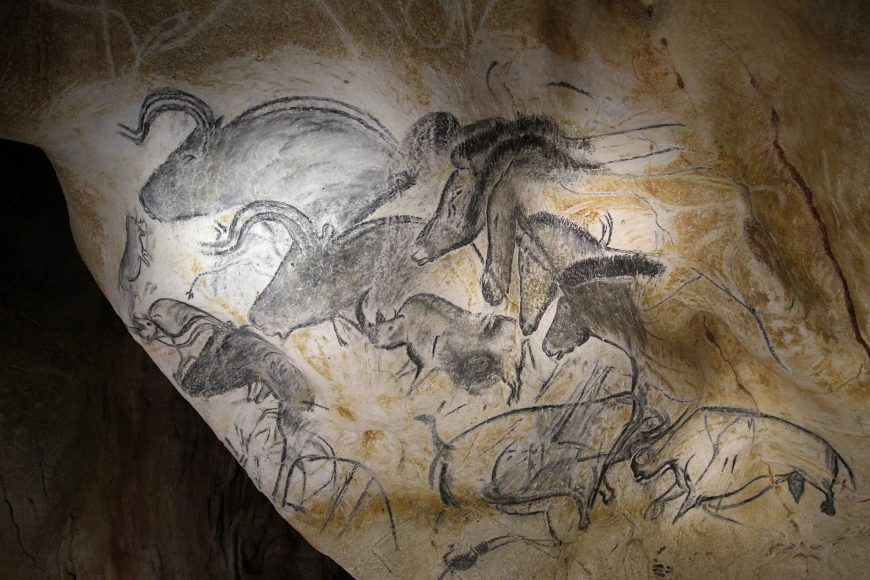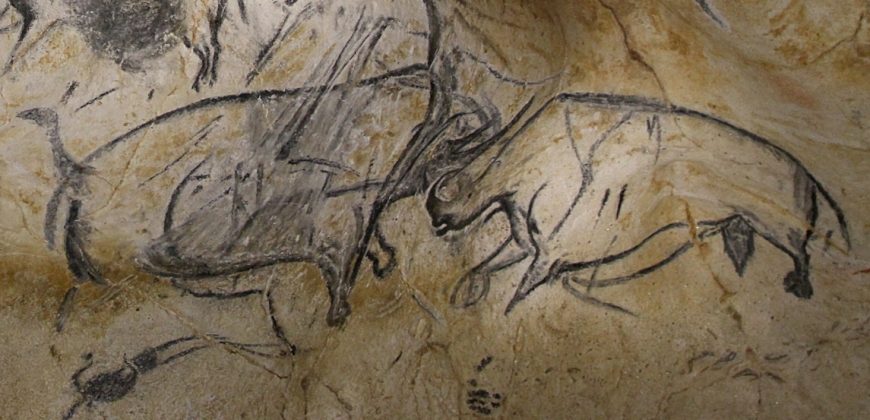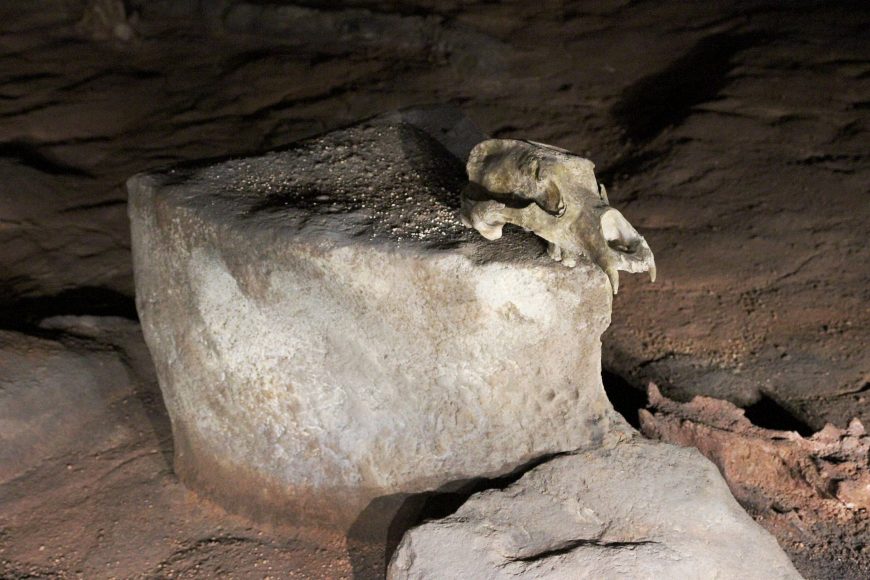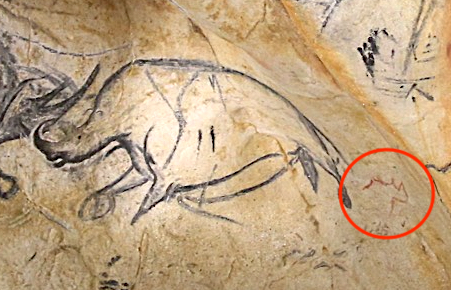
Panel of Hourses, wall painting in the Chauvet Cave (image from the Caverne du Pont d’Arc replica), France, c. 30,000–28.,000 B.C.E. or c. 15,000–13,000 B.C.E. (photo: Claude Valette, CC BY-SA 4.0)
The most recognizable works of art from prehistory are cave paintings. These works are often located very deep within narrow, twisting underground passageways as well as larger caverns.
Techniques
Prehistoric artists used a variety of techniques to make their “paintings,” many of which are not really paintings, at all. These include painting with brushes made of hair or moss, drawing with blocks of ocher or with fingers, and even chewing up charcoal and blowing it out onto the walls, using hands to create stencil-like patterns to blow over. In this way, some prehistoric artists left us their handprints. Some images were also incised (carved into the wall) or drawn in and then highlighted with some scraping, or augmented with clay added to the wall surfaces. These techniques are all laborious and serve as a testament to the efforts undertaken to produce these magnificent images.
Visual elements
The “Panel of the Horses,” as this group of prehistoric wall paintings is called, is a massive group of animals, with woolly rhinoceroses, large felines, horses, bison, reindeer, aurochs (an extinct giant ox), and even possibly a mammoth. Most of the figures seem to charge from right to left across the wall for nearly 7meters (21feet). They have a tumultuous energy that is most concentrated toward the left edge of the composition. This is achieved through density — the figures are much closer together, and there is much less blank space around them. They overlap and blend into one another.
From a distance, the composition looks like a massive herd, stampeding across a landscape. On a closer look, though, the unity of the composition breaks down. Figures that are drawn and painted right next to or on top of one another are at times drastically different in scale.

Horse Panel (detail), wall painting in the Chauvet Cave (image from the Caverne du Pont d’Arc replica), France, c. 30,000–28.,000 B.C.E. or c. 15,000–13,000 B.C.E. (photo: Claude Valette, CC BY-SA 4.0)
The set of four horses at the center are all roughly the same size. The way that they overlap has been interpreted by some as an effort to create perspective, so that the animals seem to recede into the distance in illusionistic space. The use of shading on the heads, which gives a sense that they are three-dimensional, does suggest that the artist(s) did want to create some illusion of space. However, the horse that appears closest to us is the smallest, which counters this illusion; the furthest away ought appear smallest.
In contrast to the four horses, which are close enough in size to seem like a cohesive unit, the leftmost edge has three aurochs (easily identified by their horns) with their heads pointing at a relatively tiny pair of woolly rhinoceroses. Similarly, below the lowest of the aurochs is a small figure, just roughed in, that may represent a woolly mammoth facing to the left with its trunk hanging down. This trend continues all throughout the composition, suggesting that there is no attempt to create a unified composition depicting a continuous illusion of space.
If the animals are not all in the same space, then it is unlikely that they are all moving together. Instead, it seems that there are a number of separate images and events, loosely connected. Each, though, might be taken in a number of ways. The horse heads, for example, might be in an overlapping sequence to show depth through perspective. Or they might just as well show a single horse, in a range of poses, so that each represents the same horse at different times, as it tosses its head. The front-most image may present a young horse, in which case, this may be the same horse at four times in its life. It is also possible that they are only connected conceptually, and that we are not to read any particular movement through time or space as we look from one head to the next. With prehistoric art, we can rarely be certain, since their creators did not have a written language to tell us what the artists intended or what the original audience thought.

Wooly rhinos (detail), Horse Panel, wall painting in the Chauvet Cave (image from the Caverne du Pont d’Arc replica), France, c. 30,000–28.,000 B.C.E. or c. 15,000–13,000 B.C.E. (photo: Claude Valette, CC BY-SA 4.0)
Below the horse heads, we see a pair of woolly rhinos facing one another. Again, we might read this any number of ways. The shapes of the contour lines that define the forms suggest that they are charging toward one another. The rhino on the right has very small hindquarters. The form then swells dramatically as we move toward the forequarters, so that it seems to concentrate all of its bulk and energy into its lowered head. In a similar way, the rhino on the left is abbreviated to the rear — the hind legs are not even drawn in — and the form swells to a great hump over the lowered head, again conveying a sense of the figure driving forward. They therefore seem to meet with a powerful crash. However, it has been observed that modern rhinos in the wild rub their horns together in gestures of friendly greeting. Finally, though, as with the rhinos positioned in front of the aurochs’ heads, it is possible that these two animals are not placed together to create a unified scene. Their overlapping may not indicate any direct spatial relationship, since it is clear that many of the overlaps throughout the wall do not.

Skull of a cave bear, Chauvet Cave (image from the Caverne du Pont d’Arc replica), France, c. 30,000–28.,000 B.C.E. or c. 15,000–13,000 B.C.E. (photo: Claude Valette, CC BY-SA 4.0)
In our visual analysis, we must bear in mind the setting for this wall of images. It is located some 150m (450ft) into the cave, in total darkness. It is next to a large block of stone that has the skull of a cave bear (an extinct species larger than the grizzly) atop it, and other cave bear skulls on the floor around it. As prehistoric anthropologist and art historian Christine Desdemaines-Hugon writes:
Lit by the wavering flames of tallow lamps, torches, or small fires, all the animals would spring to life, appearing to move, sway, expand to larger proportions, or momentarily disappear.Christine Desdemaines-Hugon, Stepping-Stones: A Journey through the Ice Age Caves of the Dordogne (New Haven: Yale University Press, 2010), 17.
Cultural context
With works from the historical era — that is, works made by literate cultures — we have a wealth of contextual information: names, dates, key events, religious texts, poetry, royal genealogies, and so on. But for prehistoric art, the main evidence we have to consider is visual. Certainly, we can learn a lot based on the location of the works, archeological evidence about their makers, and other contextual evidence, but the main source for information about a prehistoric work remains the work, itself.
Works like those at Chauvet Cave also serve to blast apart, from the very start, what is called the developmental model of art history, in which art is described as beginning with crude and simple works and slowly, over time, becoming more refined and sophisticated.
These spectacular cave paintings, among the earliest that survive from throughout the world, are already visually compelling and dense with possible meanings. The cave paintings remind us that art has been, and continues to be, involved in a spectrum of beliefs and practices including formal religion, but also informal beliefs in the supernatural, and even attempts to work magic.
Our species, Homo sapiens (Latin for “wise man”), evolved approximately 400,000 years ago, and our subspecies, Homo sapiens sapiens, evolved in Africa, possibly as early as 120,000 years ago, spreading from there to eventually occupy all the continents of the earth. The Chauvet Cave paintings are Paleolithic (from the Greek words for “old stone”). The period ran from approximately 2.6 million years ago (when the earliest stone tools were developed by our evolutionary ancestors) until about 10,000 years ago, ending along with the last ice age and accompanied by the development of agriculture in the Neolithic (“new stone”) period.
The earliest paintings in Chauvet Cave may date from 32,000 years ago, and yet it is striking how readily modern viewers respond to them. The naturalism and close observation of the animals is startling, especially as it is commonly assumed that art had to slowly progress from a “primitive” state toward naturalistic representations. Quite to the contrary, here at the very beginning of the artistic record, we find carefully observed animals, depicted with a sense of depth and movement.

Rhino head (detail), Horse Panel, wall painting in the Chauvet Cave (image from the Caverne du Pont d’Arc replica), France, c. 30,000– 28,000 B.C.E. or c. 15,000–13,000 B.C.E. (photo: Claude Valette, CC BY-SA 4.0)
We also, though, find striking abstraction, as in the simplified form of a rhino’s head, drawn in red behind the rightmost animal. A single contour line defines the outline of the head, with characteristic horns protruding, and a few small additions for the ears. With great economy, the artist gives a sense of the creature and, contrary to common belief, this abstraction may present a greater conceptual challenge to artists than naturalism.
What does this cave have to do with religion? In assessing any work of art, we should always ask “What was this made for?” The people who created such works did not live in the caves they decorated. They were very humid, stifling places, absolutely dark and without ventilation for fires. The caves, then, must have served a function other than shelter. They can not be seen as prehistoric art galleries, as the works are highly inaccessible and, because of the darkness, almost impossible to see. If they were not there to be seen, what were they for?
Anthropologists suggest that they were probably used for any number of activities that we might now call religion: Shamanism (access to a spirit world), animistic worship (belief that all elements of the world have souls or spirits), totemic practices (worship of animals or other beings as ancestors or protectors), or other forms of worship and ritual about which we know little.
The images are mostly of animals that were not used for food, so they are probably not tied to hunting magic, but might instead be connected with fertility or power. The great abundance of animals here and in other Paleolithic caves may suggest — or be intended to magically invoke — a fertile world that provides for the tribe so that these early humans could reproduce, as well. Some caves bear traces of ritual uses — evidence of music, suggestions of altars or offerings — that also point toward a belief in the supernatural. These Paleolithic people may not have had highly formalized religious traditions, but they almost certainly did have beliefs in supernatural powers or entities, and practices — including the creation of visual images — designed to access and perhaps influence these forces.
Because they did not write down their beliefs and intents, we cannot be certain. But the very existence of these works, produced by hunter-gatherer societies struggling for their basic survival, speaks volumes. Producing them would have been very strenuous, with artists needing to crawl through narrow passages, pulling their fat-burning lamps, tools and even scaffolding with them. Viewing them would require similar efforts.
Whatever the specifics of their function, these works were created with tremendous effort, skill, and care, all of which suggests that they believed that creating these images – which were not designed to be viewed by many people, if any at all – would be helpful to them. We might speak of magic, and we might call it religion.

